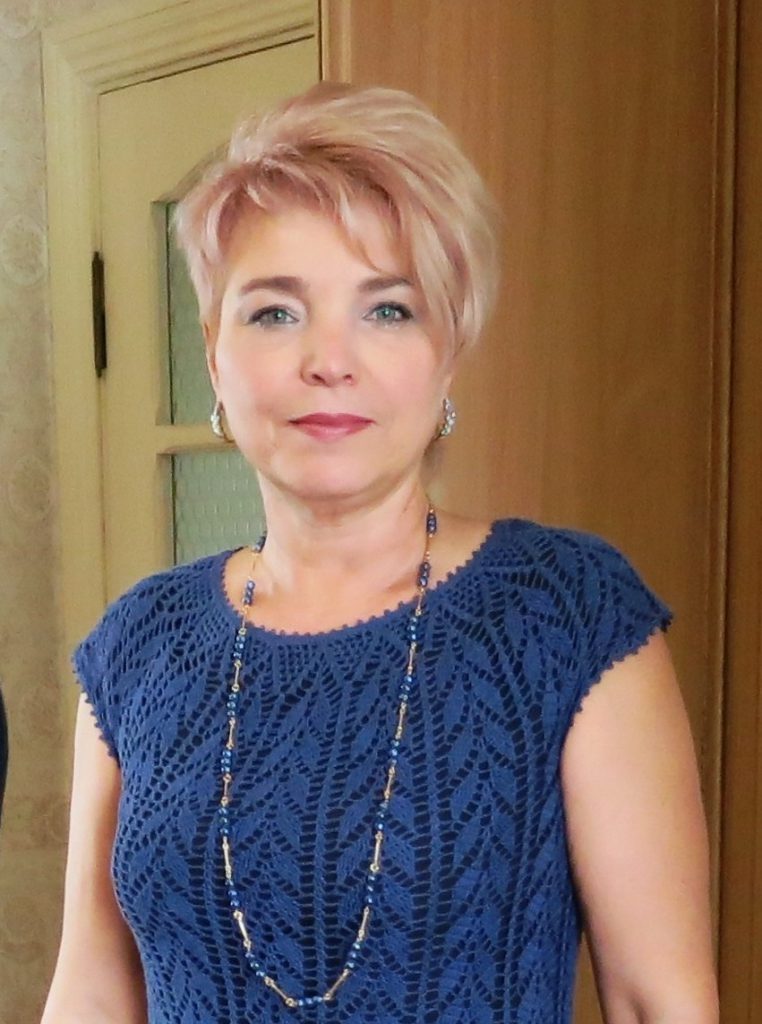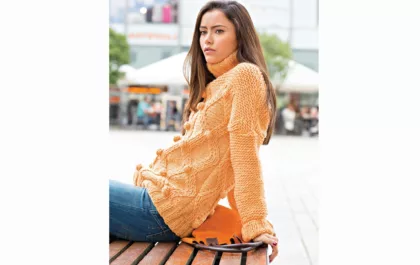The shape of the shawl is a circle, cut along the line of the “centrifugal” spiral swirl. The shawl is knitted from the top neck edge downwards, the swirl pattern smoothly transitions into an openwork border.

The shawl is knitted according to the napkin model “Ditte II” (from the book “Knitted Lace” by Sonja Esbensen and Anna Rasmussen). Ditte is a Danish girl's name.
Elena Gottlieb adapted it to the shawl.

The shawl is knitted in two threads:
– Italian yarn art. Camelot 1000m/100g (67% superkid mohair, 3% wool, 30% polyamide)
– Italian yarn Cariagi art. Jaipur 2800m/100g(70% cashmere, 30% mimosa silk)
Average final yarn length 737m/100g
– Addi knitting needles on 3.5mm fishing line
– Clover hook – 2.0mm
– beads No. 8 are crocheted with a hook No. 0.5 during the knitting process.
Finished product weight -135g including beads
Dimensions: along the ribbon – 140 cm; height 40 cm

Description of the shawl “Ditte”
In the shawl sample, the pattern repeat is repeated 11 times, and knitting according to the pattern begins from the 14th row.
Pattern for the “Ditte” shawl


To begin, cast on 3 stitches on the needles and knit 198 rows in garter stitch to make a ribbon.
There are 3 loops on the needle. Along the side edge of the ribbon, cast on 99 stitches from the edge stitches and pick up 3 loops of the ribbon cast-on row onto the same knitting needle. There are 105 stitches in total on the knitting needle (3 edge stitches + 99 shawl body loops + 3 edge loops).
Knit edge loops in all rows with facial loops, knit the body of the shawl according to the pattern in turning rows.

A fragment of the pattern from the 14th to the 38th row contains both front and back rows: even rows are purl rows (knit all loops purl, including 2 vm), odd rows are front rows (openwork). This is a "swirl" pattern.
From the 40th to the 90th row, only the front rows are shown in the diagram. In purl rows, purl all stitches.
From the 14th to the 44th row, knit the pattern exactly according to the pattern, “as is”, starting the row after the three edge loops with the rightmost symbol and ending the row before the three edge loops with the leftmost symbol.
Starting from the 46th row, after three edge stitches, knit the loops marked in the diagram with yellow dashes, being careful not to break the pattern. It should be remembered that the pattern given in the book is intended for circular knitting, where the rapport is shifted by the specified number of loops by simply throwing the loops over.


We, by moving the beginning of the row to the loops marked with yellow dashes, adapt the pattern to rotary knitting (“cut” the pattern). Thus, at the beginning of the row, loops will be gradually added, forming a sharp right corner of the shawl and lengthening the left edge of the shawl, and at the end of the row there is no need to add additional loops, let the left side of the shawl go without an angle, just vertically or even with a slight rounding towards the center shawls.
The last row of the pattern is purl 91st.

Next row (on the front side of the product) close the loops with a crochet hook, knitting 3 loops together (according to the picture!) with simple stitches, separating them with arches of 7 chain loops.
To increase the height of the shawl, you can add several openwork rows (according to the pattern!) after the 91st row and/or start knitting the shawl according to the pattern from the 11th row or even earlier, accordingly recalculating the length of the initial ribbon of 3 garter stitch loops.
Decorating shawls with beads or beads has not only an aesthetic purpose, but also a practical one. The beads make the edges of the shawl heavier and make it easier to drape.

The thinner the yarn for a shawl, the more impressive it looks, of course, but knitting with it is not so easy. Another secret for achieving openwork is to take thicker knitting needles, but with sharp tips, so that it is more convenient to pick up a thin thread. Openwork shawls will look great from any yarn, be it wool, wool blend, or linen, cotton.
And of course, blocking solves a lot. If you do not block the shawl correctly, then its appearance is no longer so impressive.

Related posts
About the Author

Welcome !
My name is Lilia. The main hobby of my life is knitting. I started with knitting needles and switched to a knitting machine. In 1988 I got acquainted with crochet - Romanian lace. About 10 years ago I became interested in Irish lace and Shetland knitting. And now I’m trying fillet crochet. On this site I want to share with you my 45 years of experience in various knitting techniques.
Latest publications
Set “Crystal Rose”
Pink flowers on a long openwork coat and a miniature hat with a veil create a romantic and mysterious image.
Пуловер спицами с узором из шишечек и ромбов
Пуловер спицами с узором из шишечек и ромбов со спущенными рукавами добавит вашему образу непринужденности и легкости. Натуральная шерстяная пряжа создаст для вас ощущение тепла и вы будете чувствовать себя комфортно даже когда на улице холод и мороз.
Blog Subscription
Be the first to receive new items!



